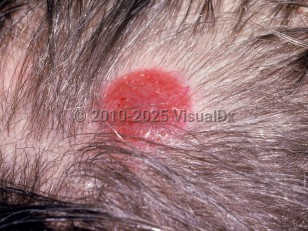Alopecia neoplastica - Hair and Scalp
Alerts and Notices
Important News & Links
Synopsis

Alopecia neoplastica (AN) is a rare presentation of cutaneous metastatic disease in the scalp. It typically presents as solitary or multiple smooth patches or plaques of scarring hair loss. Hairless areas may be skin-colored or pinkish. If skin-colored, AN may mimic the appearance of alopecia areata.
AN is usually asymptomatic, although severe scalp tenderness has been described. AN may infrequently present as larger areas of alopecia, covering up to one-third of the scalp. The more common presentation of scalp metastases is that of papules and nodules that retain hair.
Metastatic spread to the scalp occurs through lymphatic and/or hematogenous spread. In AN, there is atrophy or complete loss of the hair follicles, which is likely due to invasion of the tumor into the deep dermis with an accompanying desmoplastic reaction. Tumor infiltration of the hair follicle is an occasional occurrence. The epidermis is generally spared. Hair regrowth after treatment of the underlying malignancy is not globally seen.
Of the reported cases, the most common primary tumor sites are the gastrointestinal (GI) tract and breast (female, male), but cases of AN secondary to tumors of the kidney, lung, thyroid, uterus, liver, and central nervous system have also been reported, among others. In one study in particular, women were more affected, although men had a worse prognosis. Rarely, AN may be the presenting sign of an underlying cancer. The presence of AN (like other forms of cutaneous metastases) is a poor prognostic factor.
AN is usually asymptomatic, although severe scalp tenderness has been described. AN may infrequently present as larger areas of alopecia, covering up to one-third of the scalp. The more common presentation of scalp metastases is that of papules and nodules that retain hair.
Metastatic spread to the scalp occurs through lymphatic and/or hematogenous spread. In AN, there is atrophy or complete loss of the hair follicles, which is likely due to invasion of the tumor into the deep dermis with an accompanying desmoplastic reaction. Tumor infiltration of the hair follicle is an occasional occurrence. The epidermis is generally spared. Hair regrowth after treatment of the underlying malignancy is not globally seen.
Of the reported cases, the most common primary tumor sites are the gastrointestinal (GI) tract and breast (female, male), but cases of AN secondary to tumors of the kidney, lung, thyroid, uterus, liver, and central nervous system have also been reported, among others. In one study in particular, women were more affected, although men had a worse prognosis. Rarely, AN may be the presenting sign of an underlying cancer. The presence of AN (like other forms of cutaneous metastases) is a poor prognostic factor.
Codes
ICD10CM:
C79.2 – Secondary malignant neoplasm of skin
L66.9 – Cicatricial alopecia, unspecified
SNOMEDCT:
400088006 – Scarring alopecia
94570001 – Secondary malignant neoplasm of skin of scalp
C79.2 – Secondary malignant neoplasm of skin
L66.9 – Cicatricial alopecia, unspecified
SNOMEDCT:
400088006 – Scarring alopecia
94570001 – Secondary malignant neoplasm of skin of scalp
Look For
Subscription Required
Diagnostic Pearls
Subscription Required
Differential Diagnosis & Pitfalls

To perform a comparison, select diagnoses from the classic differential
Subscription Required
Best Tests
Subscription Required
Management Pearls
Subscription Required
Therapy
Subscription Required
References
Subscription Required
Last Reviewed:08/24/2025
Last Updated:09/14/2025
Last Updated:09/14/2025
Alopecia neoplastica - Hair and Scalp

